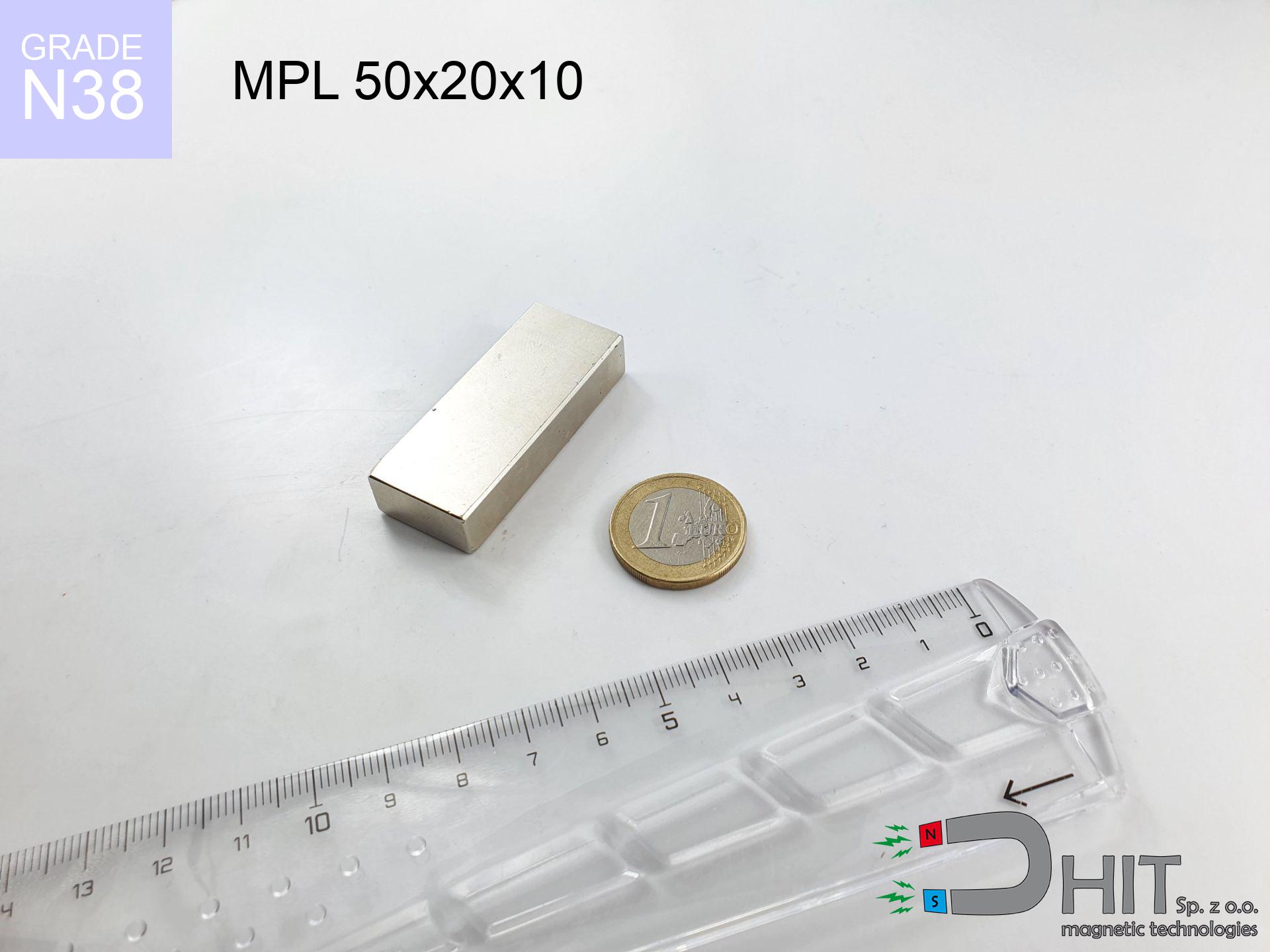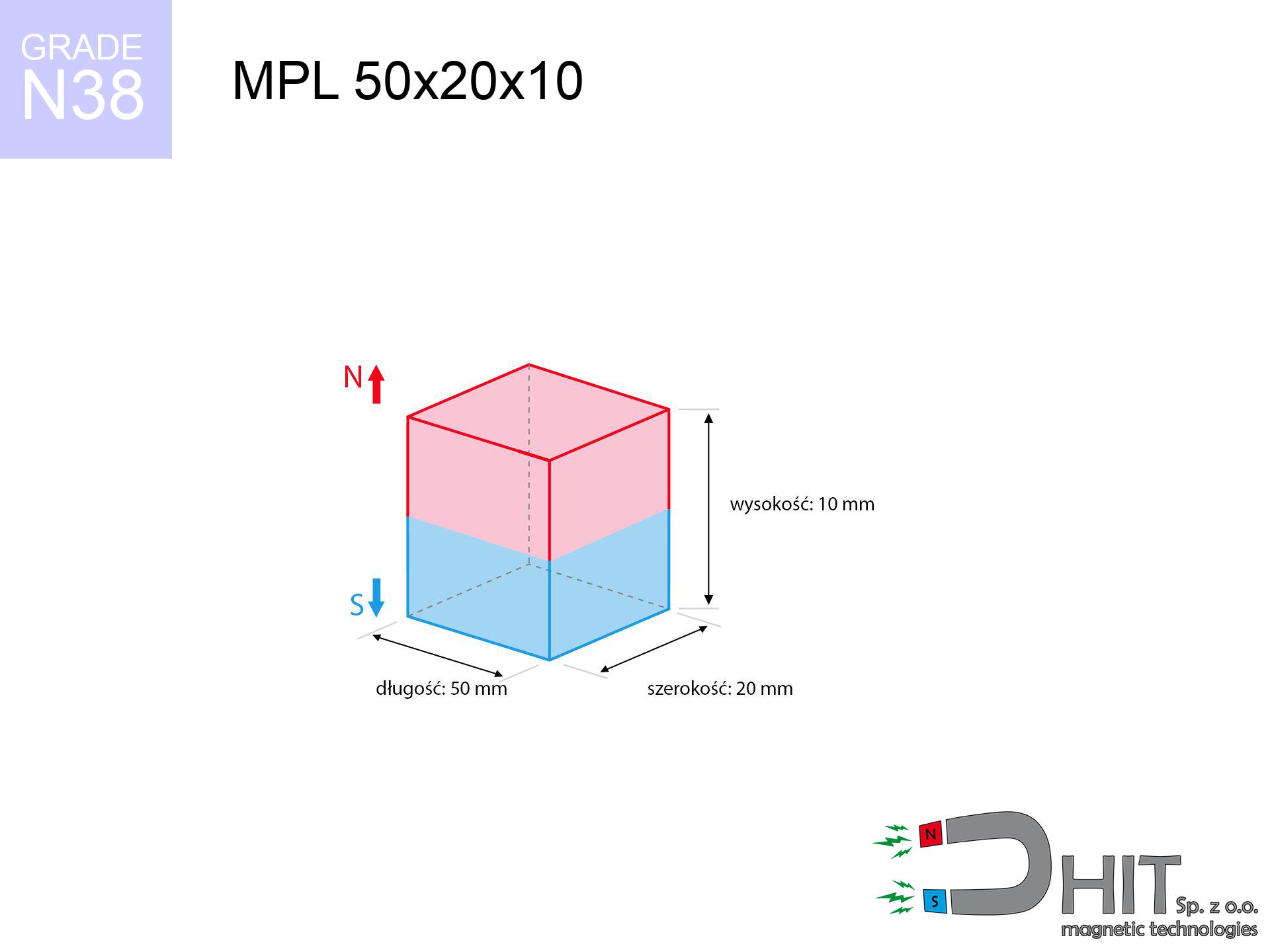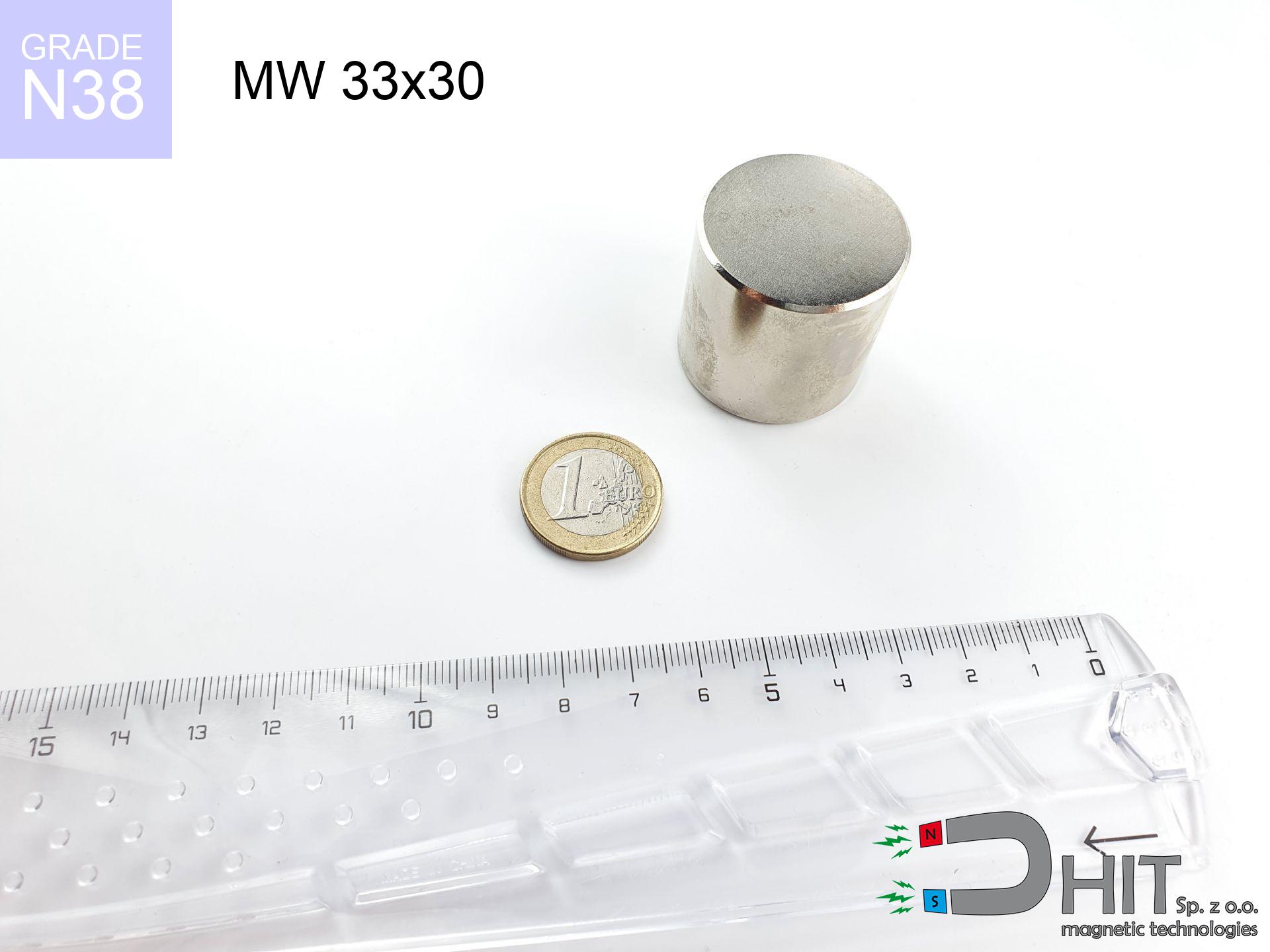MPL 50x20x10 / N38 - lamellar magnet
lamellar magnet
Catalog no 020165
GTIN/EAN: 5906301811718
length
50 mm [±0,1 mm]
Width
20 mm [±0,1 mm]
Height
10 mm [±0,1 mm]
Weight
75 g
Magnetization Direction
↑ axial
Load capacity
29.99 kg / 294.15 N
Magnetic Induction
337.18 mT / 3372 Gs
Coating
[NiCuNi] Nickel
43.05 ZŁ with VAT / pcs + price for transport
35.00 ZŁ net + 23% VAT / pcs
bulk discounts:
Need more?Looking for a better price?
Call us
+48 888 99 98 98
or send us a note via
contact form
our website.
Strength and form of a neodymium magnet can be analyzed with our
our magnetic calculator.
Same-day processing for orders placed before 14:00.
MPL 50x20x10 / N38 - lamellar magnet
Specification / characteristics MPL 50x20x10 / N38 - lamellar magnet
| properties | values |
|---|---|
| Cat. no. | 020165 |
| GTIN/EAN | 5906301811718 |
| Production/Distribution | Dhit sp. z o.o. |
| Country of origin | Poland / China / Germany |
| Customs code | 85059029 |
| length | 50 mm [±0,1 mm] |
| Width | 20 mm [±0,1 mm] |
| Height | 10 mm [±0,1 mm] |
| Weight | 75 g |
| Magnetization Direction | ↑ axial |
| Load capacity ~ ? | 29.99 kg / 294.15 N |
| Magnetic Induction ~ ? | 337.18 mT / 3372 Gs |
| Coating | [NiCuNi] Nickel |
| Manufacturing Tolerance | ±0.1 mm |
Magnetic properties of material N38
| properties | values | units |
|---|---|---|
| remenance Br [min. - max.] ? | 12.2-12.6 | kGs |
| remenance Br [min. - max.] ? | 1220-1260 | mT |
| coercivity bHc ? | 10.8-11.5 | kOe |
| coercivity bHc ? | 860-915 | kA/m |
| actual internal force iHc | ≥ 12 | kOe |
| actual internal force iHc | ≥ 955 | kA/m |
| energy density [min. - max.] ? | 36-38 | BH max MGOe |
| energy density [min. - max.] ? | 287-303 | BH max KJ/m |
| max. temperature ? | ≤ 80 | °C |
Physical properties of sintered neodymium magnets Nd2Fe14B at 20°C
| properties | values | units |
|---|---|---|
| Vickers hardness | ≥550 | Hv |
| Density | ≥7.4 | g/cm3 |
| Curie Temperature TC | 312 - 380 | °C |
| Curie Temperature TF | 593 - 716 | °F |
| Specific resistance | 150 | μΩ⋅cm |
| Bending strength | 250 | MPa |
| Compressive strength | 1000~1100 | MPa |
| Thermal expansion parallel (∥) to orientation (M) | (3-4) x 10-6 | °C-1 |
| Thermal expansion perpendicular (⊥) to orientation (M) | -(1-3) x 10-6 | °C-1 |
| Young's modulus | 1.7 x 104 | kg/mm² |
Physical analysis of the product - report
These data constitute the result of a physical analysis. Results rely on algorithms for the class Nd2Fe14B. Actual conditions might slightly deviate from the simulation results. Treat these data as a preliminary roadmap during assembly planning.
MPL 50x20x10 / N38
| Distance (mm) | Induction (Gauss) / mT | Pull Force (kg) | Risk Status |
|---|---|---|---|
| 0 mm |
3371 Gs
337.1 mT
|
29.99 kg / 29990.0 g
294.2 N
|
dangerous! |
| 1 mm |
3158 Gs
315.8 mT
|
26.32 kg / 26323.3 g
258.2 N
|
dangerous! |
| 2 mm |
2932 Gs
293.2 mT
|
22.69 kg / 22687.6 g
222.6 N
|
dangerous! |
| 3 mm |
2703 Gs
270.3 mT
|
19.29 kg / 19286.7 g
189.2 N
|
dangerous! |
| 5 mm |
2266 Gs
226.6 mT
|
13.55 kg / 13546.3 g
132.9 N
|
dangerous! |
| 10 mm |
1419 Gs
141.9 mT
|
5.31 kg / 5313.0 g
52.1 N
|
medium risk |
| 15 mm |
908 Gs
90.8 mT
|
2.17 kg / 2174.5 g
21.3 N
|
medium risk |
| 20 mm |
603 Gs
60.3 mT
|
0.96 kg / 961.0 g
9.4 N
|
weak grip |
| 30 mm |
296 Gs
29.6 mT
|
0.23 kg / 231.0 g
2.3 N
|
weak grip |
| 50 mm |
97 Gs
9.7 mT
|
0.02 kg / 24.8 g
0.2 N
|
weak grip |
MPL 50x20x10 / N38
| Distance (mm) | Friction coefficient | Pull Force (kg) |
|---|---|---|
| 0 mm | Stal (~0.2) |
6.00 kg / 5998.0 g
58.8 N
|
| 1 mm | Stal (~0.2) |
5.26 kg / 5264.0 g
51.6 N
|
| 2 mm | Stal (~0.2) |
4.54 kg / 4538.0 g
44.5 N
|
| 3 mm | Stal (~0.2) |
3.86 kg / 3858.0 g
37.8 N
|
| 5 mm | Stal (~0.2) |
2.71 kg / 2710.0 g
26.6 N
|
| 10 mm | Stal (~0.2) |
1.06 kg / 1062.0 g
10.4 N
|
| 15 mm | Stal (~0.2) |
0.43 kg / 434.0 g
4.3 N
|
| 20 mm | Stal (~0.2) |
0.19 kg / 192.0 g
1.9 N
|
| 30 mm | Stal (~0.2) |
0.05 kg / 46.0 g
0.5 N
|
| 50 mm | Stal (~0.2) |
0.00 kg / 4.0 g
0.0 N
|
MPL 50x20x10 / N38
| Surface type | Friction coefficient / % Mocy | Max load (kg) |
|---|---|---|
| Raw steel |
µ = 0.3
30% Nominalnej Siły
|
9.00 kg / 8997.0 g
88.3 N
|
| Painted steel (standard) |
µ = 0.2
20% Nominalnej Siły
|
6.00 kg / 5998.0 g
58.8 N
|
| Oily/slippery steel |
µ = 0.1
10% Nominalnej Siły
|
3.00 kg / 2999.0 g
29.4 N
|
| Magnet with anti-slip rubber |
µ = 0.5
50% Nominalnej Siły
|
15.00 kg / 14995.0 g
147.1 N
|
MPL 50x20x10 / N38
| Steel thickness (mm) | % power | Real pull force (kg) |
|---|---|---|
| 0.5 mm |
|
1.50 kg / 1499.5 g
14.7 N
|
| 1 mm |
|
3.75 kg / 3748.8 g
36.8 N
|
| 2 mm |
|
7.50 kg / 7497.5 g
73.6 N
|
| 5 mm |
|
18.74 kg / 18743.8 g
183.9 N
|
| 10 mm |
|
29.99 kg / 29990.0 g
294.2 N
|
MPL 50x20x10 / N38
| Ambient temp. (°C) | Power loss | Remaining pull | Status |
|---|---|---|---|
| 20 °C | 0.0% |
29.99 kg / 29990.0 g
294.2 N
|
OK |
| 40 °C | -2.2% |
29.33 kg / 29330.2 g
287.7 N
|
OK |
| 60 °C | -4.4% |
28.67 kg / 28670.4 g
281.3 N
|
|
| 80 °C | -6.6% |
28.01 kg / 28010.7 g
274.8 N
|
|
| 100 °C | -28.8% |
21.35 kg / 21352.9 g
209.5 N
|
MPL 50x20x10 / N38
| Gap (mm) | Attraction (kg) (N-S) | Repulsion (kg) (N-N) |
|---|---|---|
| 0 mm |
70.06 kg / 70058 g
687.3 N
4 789 Gs
|
N/A |
| 1 mm |
65.83 kg / 65828 g
645.8 N
6 535 Gs
|
59.25 kg / 59245 g
581.2 N
~0 Gs
|
| 2 mm |
61.49 kg / 61492 g
603.2 N
6 316 Gs
|
55.34 kg / 55343 g
542.9 N
~0 Gs
|
| 3 mm |
57.20 kg / 57198 g
561.1 N
6 092 Gs
|
51.48 kg / 51478 g
505.0 N
~0 Gs
|
| 5 mm |
48.94 kg / 48940 g
480.1 N
5 635 Gs
|
44.05 kg / 44046 g
432.1 N
~0 Gs
|
| 10 mm |
31.64 kg / 31645 g
310.4 N
4 531 Gs
|
28.48 kg / 28480 g
279.4 N
~0 Gs
|
| 20 mm |
12.41 kg / 12412 g
121.8 N
2 838 Gs
|
11.17 kg / 11170 g
109.6 N
~0 Gs
|
| 50 mm |
1.07 kg / 1066 g
10.5 N
832 Gs
|
0.96 kg / 960 g
9.4 N
~0 Gs
|
MPL 50x20x10 / N38
| Object / Device | Limit (Gauss) / mT | Safe distance |
|---|---|---|
| Pacemaker | 5 Gs (0.5 mT) | 15.5 cm |
| Hearing aid | 10 Gs (1.0 mT) | 12.0 cm |
| Mechanical watch | 20 Gs (2.0 mT) | 9.5 cm |
| Phone / Smartphone | 40 Gs (4.0 mT) | 7.5 cm |
| Remote | 50 Gs (5.0 mT) | 7.0 cm |
| Payment card | 400 Gs (40.0 mT) | 3.0 cm |
| HDD hard drive | 600 Gs (60.0 mT) | 2.5 cm |
MPL 50x20x10 / N38
| Start from (mm) | Speed (km/h) | Energy (J) | Predicted outcome |
|---|---|---|---|
| 10 mm |
22.29 km/h
(6.19 m/s)
|
1.44 J | |
| 30 mm |
35.10 km/h
(9.75 m/s)
|
3.56 J | |
| 50 mm |
45.12 km/h
(12.53 m/s)
|
5.89 J | |
| 100 mm |
63.77 km/h
(17.72 m/s)
|
11.77 J |
MPL 50x20x10 / N38
| Technical parameter | Value / Description |
|---|---|
| Coating type | [NiCuNi] Nickel |
| Layer structure | Nickel - Copper - Nickel |
| Layer thickness | 10-20 µm |
| Salt spray test (SST) ? | 24 h |
| Recommended environment | Indoors only (dry) |
MPL 50x20x10 / N38
| Parameter | Value | SI Unit / Description |
|---|---|---|
| Magnetic Flux | 32 980 Mx | 329.8 µWb |
| Pc Coefficient | 0.38 | Low (Flat) |
MPL 50x20x10 / N38
| Environment | Effective steel pull | Effect |
|---|---|---|
| Air (land) | 29.99 kg | Standard |
| Water (riverbed) |
34.34 kg
(+4.35 kg Buoyancy gain)
|
+14.5% |
1. Wall mount (shear)
*Note: On a vertical surface, the magnet holds just ~20% of its nominal pull.
2. Plate thickness effect
*Thin metal sheet (e.g. 0.5mm PC case) severely weakens the holding force.
3. Heat tolerance
*For standard magnets, the critical limit is 80°C.
4. Demagnetization curve and operating point (B-H)
chart generated for the permeance coefficient Pc (Permeance Coefficient) = 0.38
The chart above illustrates the magnetic characteristics of the material within the second quadrant of the hysteresis loop. The solid red line represents the demagnetization curve (material potential), while the dashed blue line is the load line based on the magnet's geometry. The Pc (Permeance Coefficient), also known as the load line slope, is a dimensionless value that describes the relationship between the magnet's shape and its magnetic stability. The intersection of these two lines (the black dot) is the operating point — it determines the actual magnetic flux density generated by the magnet in this specific configuration. A higher Pc value means the magnet is more 'slender' (tall relative to its area), resulting in a higher operating point and better resistance to irreversible demagnetization caused by external fields or temperature. A value of 0.42 is relatively low (typical for flat magnets), meaning the operating point is closer to the 'knee' of the curve — caution is advised when operating at temperatures near the maximum limit to avoid strength loss.
Elemental analysis
| iron (Fe) | 64% – 68% |
| neodymium (Nd) | 29% – 32% |
| boron (B) | 1.1% – 1.2% |
| dysprosium (Dy) | 0.5% – 2.0% |
| coating (Ni-Cu-Ni) | < 0.05% |
Sustainability
| recyclability (EoL) | 100% |
| recycled raw materials | ~10% (pre-cons) |
| carbon footprint | low / zredukowany |
| waste code (EWC) | 16 02 16 |
See more products
Advantages and disadvantages of Nd2Fe14B magnets.
Pros
- They retain attractive force for almost 10 years – the drop is just ~1% (based on simulations),
- They feature excellent resistance to magnetism drop due to external magnetic sources,
- By applying a decorative layer of gold, the element has an professional look,
- Magnets have huge magnetic induction on the outer side,
- Thanks to resistance to high temperature, they can operate (depending on the shape) even at temperatures up to 230°C and higher...
- Thanks to flexibility in forming and the ability to adapt to unusual requirements,
- Huge importance in innovative solutions – they are commonly used in mass storage devices, electric drive systems, advanced medical instruments, also complex engineering applications.
- Thanks to their power density, small magnets offer high operating force, with minimal size,
Limitations
- To avoid cracks under impact, we suggest using special steel holders. Such a solution protects the magnet and simultaneously improves its durability.
- When exposed to high temperature, neodymium magnets suffer a drop in force. Often, when the temperature exceeds 80°C, their strength decreases (depending on the size, as well as shape of the magnet). For those who need magnets for extreme conditions, we offer [AH] versions withstanding up to 230°C
- They rust in a humid environment. For use outdoors we suggest using waterproof magnets e.g. in rubber, plastic
- Limited ability of producing threads in the magnet and complex shapes - preferred is a housing - magnetic holder.
- Health risk related to microscopic parts of magnets pose a threat, if swallowed, which becomes key in the context of child health protection. Furthermore, small elements of these products can be problematic in diagnostics medical in case of swallowing.
- Higher cost of purchase is one of the disadvantages compared to ceramic magnets, especially in budget applications
Holding force characteristics
Highest magnetic holding force – what affects it?
- using a sheet made of low-carbon steel, serving as a ideal flux conductor
- possessing a massiveness of minimum 10 mm to ensure full flux closure
- with a plane cleaned and smooth
- without any air gap between the magnet and steel
- during detachment in a direction vertical to the mounting surface
- at ambient temperature room level
Practical aspects of lifting capacity – factors
- Space between magnet and steel – even a fraction of a millimeter of separation (caused e.g. by veneer or dirt) diminishes the magnet efficiency, often by half at just 0.5 mm.
- Loading method – catalog parameter refers to detachment vertically. When slipping, the magnet holds significantly lower power (typically approx. 20-30% of nominal force).
- Metal thickness – thin material does not allow full use of the magnet. Part of the magnetic field passes through the material instead of generating force.
- Steel grade – the best choice is pure iron steel. Cast iron may generate lower lifting capacity.
- Base smoothness – the more even the surface, the better the adhesion and higher the lifting capacity. Roughness acts like micro-gaps.
- Thermal environment – temperature increase causes a temporary drop of induction. It is worth remembering the maximum operating temperature for a given model.
Holding force was measured on a smooth steel plate of 20 mm thickness, when a perpendicular force was applied, whereas under shearing force the holding force is lower. Additionally, even a small distance between the magnet and the plate decreases the lifting capacity.
Thermal limits
Regular neodymium magnets (grade N) undergo demagnetization when the temperature surpasses 80°C. Damage is permanent.
Crushing force
Danger of trauma: The pulling power is so immense that it can result in blood blisters, crushing, and even bone fractures. Protective gloves are recommended.
Life threat
Patients with a heart stimulator should maintain an safe separation from magnets. The magnetism can stop the operation of the implant.
Immense force
Handle magnets with awareness. Their immense force can surprise even professionals. Plan your moves and do not underestimate their power.
Phone sensors
A powerful magnetic field interferes with the operation of magnetometers in smartphones and GPS navigation. Maintain magnets close to a device to prevent damaging the sensors.
Dust explosion hazard
Mechanical processing of neodymium magnets poses a fire risk. Neodymium dust oxidizes rapidly with oxygen and is difficult to extinguish.
Protect data
Do not bring magnets close to a wallet, computer, or TV. The magnetism can irreversibly ruin these devices and wipe information from cards.
Nickel coating and allergies
Medical facts indicate that the nickel plating (standard magnet coating) is a common allergen. For allergy sufferers, refrain from direct skin contact and opt for coated magnets.
This is not a toy
Adult use only. Tiny parts can be swallowed, causing severe trauma. Keep away from children and animals.
Beware of splinters
Watch out for shards. Magnets can fracture upon violent connection, launching shards into the air. Wear goggles.






![UMP 94x28 [3xM10] GW F300 GOLD Lina / N38 - search holder UMP 94x28 [3xM10] GW F300 GOLD Lina / N38 - search holder](https://cdn3.dhit.pl/graphics/products/ump-94x28-m10-gw-f300-+lina-kac.jpg)


